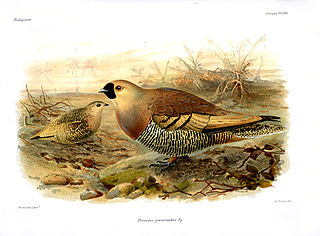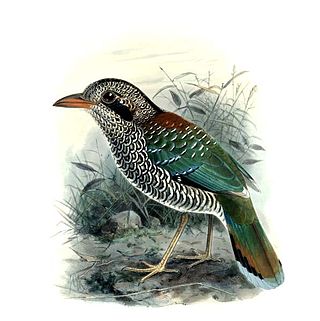
The grey-headed chachalaca is a member of an ancient group of birds of the family Cracidae, which includes chachalacas, guans, and curassows. It is found from Honduras to Colombia.

The brown mesite is a ground-dwelling bird endemic to Madagascar. It is one of three species in the mesite family or the Mesitornithidae, and though classified as vulnerable by the International Union for Conservation of Nature (IUCN), it is the most widespread of the three.

Appert's tetraka formerly known as Appert's greenbul is a small passerine bird endemic to the south-west of Madagascar. The species was only described in 1972, and has been the subject of considerable taxonomic confusion. It was initially placed in the greenbul genus Phyllastrephus, and later with the Old World warblers in the genus Bernieria. Recent research indicates it is part of an endemic Malagasy radiation currently known as the Malagasy warblers.

The Tibetan eared pheasant, also called Elwes' eared pheasant, is a species of bird in the family Phasianidae found in southeast Tibet and adjacent northern India, usually between 3,000 and 5,000 m elevation, but has been seen down to 2,280 m (7,500 ft) in winter. The species is named after Henry John Harman.

The spectacled tetraka is a species of Malagasy warbler in the family Bernieridae. It is found only in Madagascar. Its natural habitat is subtropical or tropical moist lowland forests.

The cryptic warbler is a species of Malagasy warbler in the family Bernieridae. It was formerly placed in the Old World warbler family Sylviidae. It was first discovered in 1992 near the Analamazaotra Special Reserve in Madagascar, and is endemic to the forests on the eastern part of island between Anjanaharibe-Sud Special Reserve and Andohahela National Park.

The Malagasy brush warbler, also known as the Madagascar brush warbler, is a species of Old World warbler in the family Acrocephalidae.. The Malagasy brush warbler is a widespread species of forest undergrowth and is found primarily in both Madagascar and the Comoro Islands. The bird is typically found alone or in pairs of 2 and flies short distances due to a small wingspan. Its natural habitats are subtropical or tropical dry forests, subtropical or tropical moist lowland forests, and subtropical or tropical moist shrubland.

The white-eared tailorbird is a species of bird formerly placed in the "Old World warbler" assemblage, it but now placed in the family Cisticolidae.It is found in the Philippine islands of Basilan and West Mindanao.

Rand's warbler is a species in the family Bernieridae. It is found only in Madagascar, where it is restricted to the island's eastern rainforests. It is grey above and unmarked pale below, with a strong pale supercilium. The bill is strong and slightly decurved, with some individuals possessing a pale orange lower mandible.

The thamnornis or thamnornis warbler is a species of Malagasy warbler in the family Bernieridae. It is endemic to Madagascar, where it is restricted to the spiny forest of the island's southwest. It is greyish above and whitish below, with narrow green fringes to the wing feathers and a marked supercilium. The outer tail-feathers have pale tips.
The Tawitawi brown dove, also dark-eared brown dove, is a threatened species of bird in the family Columbidae noted for its orange-peach breast. It is endemic to forests in the Sulu Archipelago in the Philippines. Until recently it was considered conspecific with the Mindanao brown dove and collectively called the dark-eared brown dove. Although threatened by habitat loss, the rate of loss significantly reduced from 2004 to 2007, and it was thus downlisted from Critically Endangered to Endangered status in the 2007 IUCN Red List.

The Madagascar sandgrouse is a species of bird in the family Pteroclidae. It is endemic to Madagascar and is a ground-dwelling short-legged plump bird. The head of the male is brown with a black area surrounding the beak. It has a pinkish-buff coloured breast, a light brown mottled back, brown wings and paler underparts barred with dark brown. The female has a generally duller appearance being cryptically coloured brown with dark specks and bars.

The scaly ground roller is a species of bird in a monotypic genus in the near-passerine family Brachypteraciidae. It is endemic to eastern Madagascar. Its natural habitat is subtropical or tropical moist lowland forest. The scaly ground roller is found at elevations below 1,000 meters (3,300 ft), and one of the few birds of Madagascar to reside in lowland rainforest.

The Madagascar flufftail is a species of bird in the family Sarothruridae. It is endemic to Madagascar. The subspecies is Monotypic.

The Madagascar blue vanga is a bird species in the family Vangidae. It is found in Madagascar, where its natural habitats are subtropical or tropical dry forest and subtropical or tropical moist lowland forest.

Archbold's newtonia is a species of bird in the family Vangidae. It is endemic to Madagascar. Its natural habitats are subtropical or tropical dry forests and subtropical or tropical dry shrubland. The birds have a greyish brown back and tail, with a rufous forecrown and a buffy white belly, throat, and undertail coverts. They have a conspicuous rufous eye-ring, accompanied with a black bill and pale yellow eyes. The species is sexually monomorphic, and there is no major difference between the sexes. There is no breeding plumage for the males.

The green shrike-babbler is a bird species that was earlier placed in the family Timaliidae. The species is now considered to be an Asian offshoot of the American vireos and belongs in the family Vireonidae.

The Amazonian antshrike is a species of bird in subfamily Thamnophilinae of family Thamnophilidae, the "typical antbirds". It is found in every mainland South American country except Argentina, Chile, Paraguay, and Uruguay.

Stierling's woodpecker is a species of bird in the family Picidae. It is native to Malawi, Mozambique, and Tanzania where its natural habitat is tropical dry forests in the Eastern miombo woodlands ecoregion. It is threatened by habitat destruction. The bird is named in honour of the German bird collector N. Stierling.
Kalambatritra Special Reserve is a wildlife reserve in southern Madagascar. It is to the north of Andohahela National Park, south-west of the Manombo Special Reserve and contains many endemic species, including forty-five endemic bird species.



















